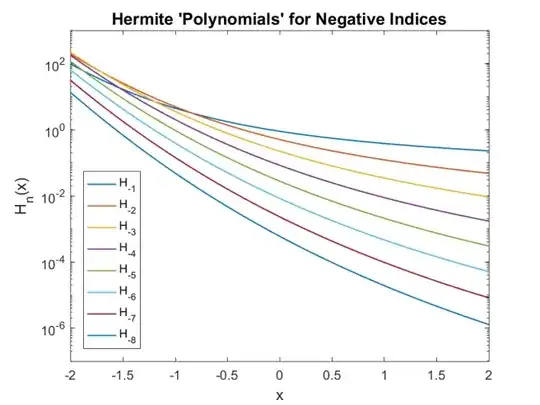Take $n \in {\mathbb N}$ and $n \ge 1$. By generalizing the Rodrigues's formula to negative values of $n$ we write:
\begin{eqnarray}
&&H_{-n}(x) := (-1)^{n+1} e^{x^2} \cdot \int\limits_x^\infty \frac{(x-t)^{n-1}}{(n-1)!} e^{-t^2} dt \\
&&= \frac{(-1)^{n-1}}{(n-1)!} \frac{1}{2} \sum\limits_{j=0}^{n-1}
\sum\limits_{m=0}^{\lfloor \frac{j}{2} \rfloor}
\binom{n-1}{j} x^{n-1-j} (-1)^j (\frac{j-1}{2})_{(m)} \left( \right. \\
&& \left.
x^{j-1-2 m} 1_{m < \lfloor \frac{j}{2} \rfloor} +
[1 \cdot 1_{j\%2=1} + \sqrt{\pi} e^{x^2} \mbox{erfc}(x) 1_{j\%2=0}] 1_{m = \lfloor \frac{j}{2} \rfloor} \right. \\
&& \left.
\right) \\
&&=\frac{(-1)^{n-1}}{2(n-1)!}\underline{\sum\limits_{j=0}^{\lfloor \frac{n-2}{2} \rfloor} \left(j!\sum\limits_{m=2j+1}^{n-1}\binom{n-1}{m} (-1)^m \binom{\frac{m-1}{2}}{j}\right) x^{n-2-2j}} + \\
&&\frac{(-1)^{n-1}}{2(n-1)!}\underline{\sum\limits_{j=0}^{\lfloor \frac{n-1}{2} \rfloor} \binom{n-1}{2 j} \cdot (\frac{1}{2})^{(j)} x^{n-1-2 j} }\cdot \sqrt{\pi} e^{x^2} \mbox{erfc}(x)
\end{eqnarray}
where $j_{(m)} := j(j-1)\cdots(j-m+1)$ is the lower Pochhammer symbol.
In[243]:= x =.; mm = 20;
Table[(-1)^(n - 1)/(n - 1)! 1/2 Sum[
Binomial[n - 1, j] x^(n - 1 - j) (-1)^
j Pochhammer[(j - 1)/2 - m + 1, m] If[m < Floor[j/2],
x^(j - 1 - 2 m),
If[Mod[j, 2] == 1, 1, Sqrt[\[Pi]] E^x^2 Erfc[x]]], {j, 0,
n - 1}, {m, 0, Floor[j/2]}] - HermiteH[-n, x], {n, 1, mm}] //
FunctionExpand // Simplify
Table[ (-1)^(-1 + n)/(2 (-1 + n)!)
Sum[(Sum[
Binomial[n - 1, m] (-1)^m Binomial[(m - 1)/2, j], {m,
2 j + 1, n - 1}] j!) x^(n - 2 - 2 j), {j, 0,
Floor[(n - 2)/2]}] + (-1)^(-1 + n)/(2 (-1 + n)!)
Sum[Binomial[n - 1, 2 j + 0] Pochhammer[1/2,
j] x^(n - 1 - 2 j) , {j, 0, Floor[(n - 1)/2]}] Sqrt[\[Pi]] E^
x^2 Erfc[x] +
-HermiteH[-n, x]
, {n, 1, mm}] // FunctionExpand // Simplify
Out[244]= {0, 0, 0, 0, 0, 0, 0, 0, 0, 0, 0, 0, 0, 0, 0, 0, 0, 0, 0, 0}
Out[245]= {0, 0, 0, 0, 0, 0, 0, 0, 0, 0, 0, 0, 0, 0, 0, 0, 0, 0, 0, 0}
It turns out that those quantities appear in a natural way in stochastic processes, in the formula for the probability density function of the first hitting time of a certain diffusion process, as demonstrated in my answer to this question.
